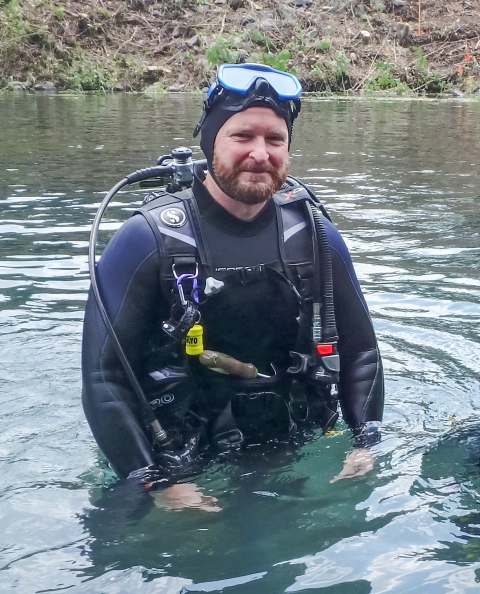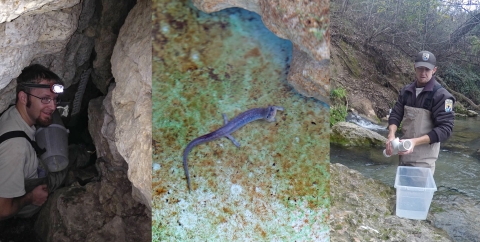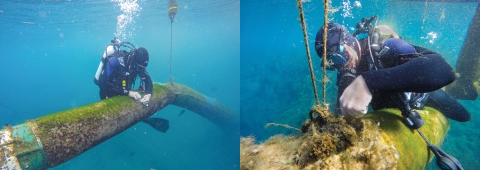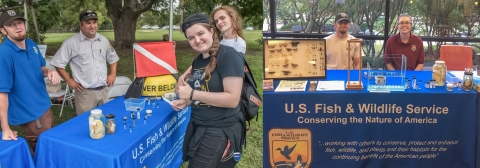From countless hours spent outdoors to finding a passion for nature in a memorable moment, the staff of the U.S. Fish and Wildlife Service all have varied paths that led us to choose our careers. Those unique stories make up the Service's heart and soul and help to inspire others to pursue a similar path. Each story is worthy of the spotlight.
Justin Crow, a Fish Biologist stationed at the San Marcos Aquatic Resources Center in Texas, is a prime example of someone whose passion for fish and wildlife started as a kid and led to a career with the Service.
“I have always been fascinated with animals,” Crow said. ”Like many, I grew up catching lizards, snakes, bugs, and fish just to observe them for a while before letting them go. I still catch lizards, snakes, bugs, and fish as an adult. Their biology is fun and fascinating. This interest led me to a bachelor's degree in Marine and Freshwater Biology and then a Master's in Biology.”
Having a passion for wildlife might have been the spark that fueled Crow to become a biologist, but equally as pivotal was the choice to pursue an internship with the Service.
"After finishing my undergraduate degree, I was selected for a pathways internship with the Service, allowing me to work with three federally listed salamanders in Central Texas (Barton Springs salamander, Texas blind salamander, and San Marcos salamander),” Crow said. “During this internship, I worked on salamander-related research with several partners from Texas State University, the City of Austin, and the City of San Marcos.”
Crow's pathways internship provided experience and learning opportunities and revealed the need for amphibian research that would later define his master's research and future role with the Service.
“I quickly discovered that a lot of research and conservation work was being conducted for amphibians, and much more is still needed, specifically on salamanders,” Crow said. "There were three federally listed salamanders at the time of my internship, with four under review for listing. Given the need, a significant effort was put toward gathering as much data as possible for these salamanders and their habitats. The experience led me to obtain my master's degree by conducting thermal and toxicity tolerance experiments to determine certain thresholds for these salamanders.”
Crow's contributions are a vital part of the Service's efforts to preserve endangered and threatened species. One such species, the Houston toad, has become a clear favorite after working with them daily for many years.
"I am the lead biologist for the federally endangered Houston toad and Barton Springs salamander conservation programs at the San Marcos Aquatic Resources Center,” Crow said. “I also work with the Texas blind, Comal Springs, and San Marcos salamanders at our center. Each of these amphibians is highly endemic and unique to specific areas in Texas.”
“Over the years, I have been able to study these species in the lab and the wild and learn fascinating things about their biology and interactions within their habitat. At our center, I get to provide husbandry and conduct research on the previously stated amphibians. One of the most rewarding parts of my job is when I get to breed our Houston toads and release the eggs into the wild.”
Crow is passionate about helping to recover endangered and threatened species and the ecosystems they rely on. During the day-to-day of those efforts, one of the many tasks carried out by Crow is helping to conduct underwater surveys and other projects that require the dawning of scuba gear. It is because of some of these experiences that scuba diving has become a favorite part of the job.
"As a USFWS diver, I am able to use SCUBA to survey aquatic animals in the wild and conduct projects requiring SCUBA,” Crow said. My favorite dive was during a regional training exercise in Florida. As part of the training, we were able to dive several reefs off Destin, Florida, to survey for invasive lionfish.”
Another aspect of the job is outreach. The need to communicate science and promote future generations to become stewards of the environment is a vital mission for the Service. Taking the time to help others follow their passion with the Service is a great step in that direction.
"One of the best ways to get involved and get your foot in the door early in your education is to volunteer or apply for internships,” Crow said. You will meet many people with a variety of experiences, but this will also allow you to work in the field you are interested in and potentially learn about new opportunities.”









